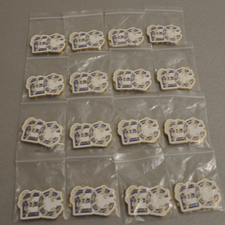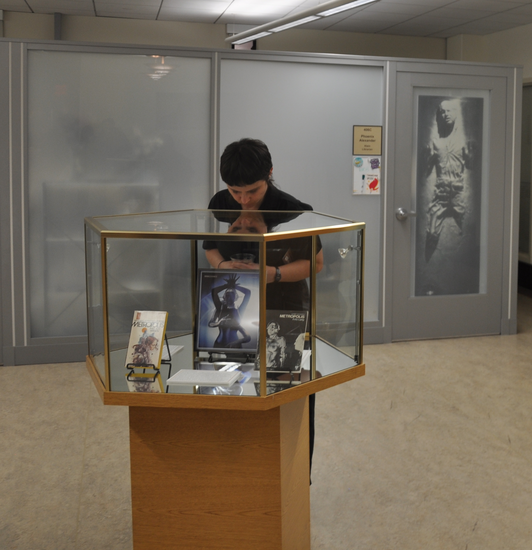From Jules Verne to Star Wars to Beyoncé, the many facets of science fiction and fantasy in popular culture are on display in a new exhibit at UC Riverside’s Tomás Rivera Library.
“Eaton at the Movies” showcases film and television-related items from the Eaton Collection of Science Fiction and Fantasy, which has more than 300,000 pieces of science fiction, fantasy, horror, and utopian literature, making it one of the largest collections of its kind in the world.
The new exhibit is the first to showcase new and old items since the pandemic, including some that have never been publicly exhibited before, said Steven Mandeville-Gamble, UCR’s university librarian.
“This feels like a reawakening of our Eaton Collection of Science Fiction and Fantasy, which we’ve been steadily building during the pandemic,” he said.
As part of that celebration, the library unveiled a new logo for the collection created by John Jennings, a professor of media and cultural studies and a Hugo Award-winning graphic novelist and illustrator. Special commemorative pins with the “EC” logo were given to guests at a reception held Feb. 8 to launch the new exhibit.
"My main concept for the logo was to give the impression of someone being on a spaceship and looking out at the vastness of space," Jennings said.
The exhibit is open to visitors through July and can be found on the fourth floor of the Rivera Library from 10 a.m. to 4 p.m. Monday through Friday. It is separated into several themes with items that range from recognizable pop culture brands to deep cuts from archival collections, said Phoenix Alexander, the Jay Kay and Doris Klein Science Fiction librarian who curated the exhibit.
“People love film and TV,” he said. “People love science fiction. I wanted it to be a crowd-pleasing exhibit.”
It's the first exhibit Alexander has overseen on his own as curator of the Eaton Collection since he joined UCR in August 2022.
Alexander conducted extensive research in the Eaton Collection’s holdings, looking through unprocessed collections to find items he knew had to be part of the exhibit. One of his favorites is a photograph of a young Ray Bradbury, the famed science fiction writer, with film star Marlene Dietrich.
One display case spotlighting monster films features a recently acquired collection from the 1976 “King Kong” remake including the shooting script.
The blockbuster “Star Wars” franchise is represented in the “Space Samurai” display case and shows early concept art by legendary illustrator Ralph MacQuarrie. Phoenix noted how the initial design for the droid C-3PO resembled the robot from the 1927 film “Metropolis,” and how Darth Vader’s helmet resembled a samurai’s. One of MacQuarrie’s drawings serves as the main art for the exhibit brochure.
Visitors to the exhibit are invited to send a message through a displayed R2-D2 model, dropping notes into a replica of the droid.
The other big “Star” franchise is represented with shooting scripts from the original 1966 “Star Trek” television series and the 1993 spin-off “Star Trek: Deep Space Nine,” as well as a photograph of actress Nichelle Nichols, who played Lt. Uhura.
Alexander said he wanted the exhibit to display a wide variety of items that showcase the range of science fiction and its influences.
For instance, one display spotlights rare books, including an 1874 edition of Jules Verne’s “From the Earth to the Moon” and a copy of his 1899 novel “The Will of an Eccentric,” which both served as inspiration for filmmakers like Georges Méliès, whose biography is also included.
Those early forays into science fiction are connected to pop culture’s present with a display spotlighting the 1927 film “Metropolis” that includes a poster from last year’s “Beyoncé: Renaissance” concert film, showing the singer in a sleek silver metallic body suit that references the robot from the Fritz Lang classic.
“It just helps tie all these science fiction iconographies, visual history, and visual culture into the present, so folks can see how a film from 1927 can have such an enduring legacy,” Alexander said.
Header photo: UCR/Stan Lim








